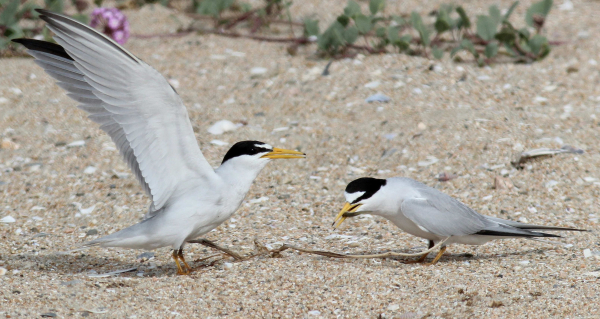 Least Terns are among the birds you may encounter at during a visit to a local beach. Here a male is offering a female a small fish as part of pre-nesting behavior (photo by Paul Konrad)
|
This summer, millions of people and birds will be sharing the beach along our ocean coasts, lakeshores, rivers, islands, and sandbars; and the American Bird Conservancy (ABC) is reminding beachgoers and island visitors to watch out for birds that are already beginning to nest and raise young along the varied beaches. The ABC recommends that beachgoers help coastal birds by keeping a safe distance from birds and avoiding locations with signs indicating nesting areas. On beaches where birds are nesting and raising young, remember to “fish, swim, and play from 50 yards away.”
Birds like plovers, terns, and skimmers rely on beach habitat to reproduce each spring and summer, and people can make it more challenging for these birds to nest successfully. Eggs, nestlings, and hatchlings can be overlooked and trampled underfoot or run over by vehicles. Young birds can also be killed by predators when they are flushed from their nests or foraging areas by people or off-leash pets that get too close. Disturbed adult birds can be distracted from taking care of their hatchlings, or they may abandon their nests or young as a result of nearby disturbances. Of course, we all want to enjoy our visits to the beach, but please keep a few things in mind before and during each beach visit.
Tips for Sharing the Beach with Birds
Watch your step – Some birds lay their eggs directly on the sand, where their eggs are camouflaged to blend in with their surroundings. The ABC recommends that beachgoers avoid areas where birds are active.
Follow the signs – Please respect areas that are roped off or marked with signs indicating that birds are nesting in the vicinity.
Teach children to avoid nesting areas. Encourage kids to learn about and watch out for birds. Ask them to play a safe distance away from nesting birds to avoid disturbing birds.
Don’t feed gulls – Feeding gulls will attract these predators and scavengers that will also prey on eggs and vulnerable hatchlings whenever possible. Also, human food is a choking hazard and has less nutrients than the natural diet of gulls.
Keep dogs on leashes, or at home – Free-roaming dogs mimic natural predators to birds, causing stress adult birds and even direct harm to eggs, nestlings, and hatchlings. Dogs can also overheat and become dehydrated at the beach, so for their safety as well as that of the safety of birds, consider keeping them at home. There are ample reasons why dogs are not permitted on many beaches.
Know the cues – It can be difficult to tell the difference between a bird that is simply resting on the sand and one that is incubating eggs, or caring for nestlings or hatchlings. But certain signals and behaviors indicate the presence of nesting birds: Nesting birds will often call loudly, dive at perceived intruders, or feign a broken wing injury to lead you away from the nest. If you see any of these behaviors, please move away from the birds until they no longer seem agitated and avoid that area during your beach activities.
Stay close to the water – Most nesting birds tend to use elevated parts of the beach, away from the surf. It should be possible to avoid conflict with birds nesting on the beach as long as people remain close to the water and away from the dunes or areas behind dunes.
Please pick up plastic – Birds can be killed by plastic pollution when they accidentally ingest tiny bits of plastic or become tangled in larger pieces. To cut down on plastic at the beach, please discard fishing line appropriately, properly dispose of and recycle plastic bottles and containers, and please pick up any litter you may find – consider it your good deed.
Taking these actions will do far more than allow these beach nesting birds to survive and reproduce, they will also improve your beach experiences with an increased awareness of and appreciation for the nature of the beach and shores. Different regions of the country have different birds nesting on the beaches, but most birds have similar behaviors and reactions to being disturbed. Knowing what birds you might encounter will help you avoid alarming or harming any birds, and identifying and learning more about the birds you see can make your beach trips even more fun.
For more information, you can refer to this American Bird Conservancy article: Headed to the Beach? Follow These Tips for a Bird-Friendly Visit - American Bird Conservancy (abcbirds.org)
